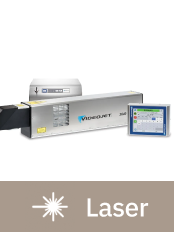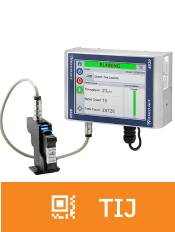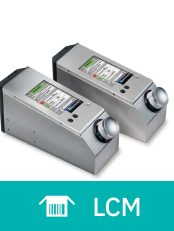How to pick the right technology for your business
Your factory operations are constantly changing. Whether you’re adapting to new customer requirements or a change in regulations, you need the best technology for your unique needs. Understanding which marking and coding options you have available can be the difference between an efficient production process and one that experiences frequent downtime.
Get expert help: (866) 871-3226
What characteristics should you consider?
![]() Application
Application
It all starts with the type of material you want to mark. Not all technologies are compatible with every material, and some provide unique advantages. When beginning your search, identifying your material is the best place to start.
![]() Production line and printing speed
Production line and printing speed
Certain technologies have higher capacities, but speed can also be a trade off with higher resolution and more complex images. Make sure your marking technology can match your line speed.
![]() Print quality and permanence
Print quality and permanence
What type of information are you printing? Is it health related or mandatory legal information? Depending on your use case, higher print quality can protect your customers or prevent costly fines.
![]() Are variable data or graphics required?
Are variable data or graphics required?
Knowing if you’ll print variable data, QR codes, bar codes, or graphics can help you further narrow down any specific functionality that you’ll require.
![]() Budget
Budget
What is your budget? Are you making a one-time purchase, or will you have an ongoing budget? Some technologies, such as laser, have higher upfront costs, but lower operating costs.
Technology options
![]() Continuous inkjet (CIJ)
Continuous inkjet (CIJ)
Continuous ink jet, or CIJ, is one of the most popular forms of non-contact marking technologies. CIJ is an ink-based solution capable of printing of up to five lines of text and 2D bar codes.
Customers like you choose CIJ due to its high-speed capability, ease of integration, and reliability. Additionally, CIJ is extremely versatile, capable of marking on almost any material, on flat or curved surfaces, and in harsh production environments. The CIJ printer’s high-tech capabilities are built with you in mind. The smooth user experience, auto-cleaning printheads, and code assurance capabilities help keep your production line moving, with long run times between preventative-maintenance.
Use cases
- Commonly used to print batch codes, serial numbers, barcodes, and other traceability information on both products and packaging.
- Codes can be applied in a variety of fonts, lines and directions at speeds up to 1,000 feet/min. and with code heights ranging from 1/32-inch to more than ½-inch.
Learn more about CIJ technology
See all CIJ products
![]() Laser marking systems
Laser marking systems
Laser technologies are a highly sophisticated, non-contact solution that use a beam of infrared light to melt, foam, or remove surface materials, creating permanent markings.
While lasers are typically more expensive, customers love their exceptionally low operating costs . They don’t require consumables and can operate without maintenance for thousands of hours. If your business has high volume, fully automated production lines, or a need for precise, permanent markings, laser coding could be an ideal solution.
Use cases
- Capable of working at ultra-high speeds up to 150,000 cans per hour
- Often used to mark numbers, bar codes, matrices, logos and symbols
- Typical applications include glass, plastic, aluminum, metal, labels, and films
Learn more about Laser technology
See all Laser products
![]() Thermal transfer overprinters (TTO)
Thermal transfer overprinters (TTO)
Thermal transfer overprinting, or TTO, uses a thermal printhead to print on flexible materials. TTO does require contact with the material you’re printing on, and uses heat from the printhead to precisely melt ink from a ribbon directly onto that material.
TTO stands out to customers because it can print nearly any type of information in high resolution and at high speeds. This makes it a great technology for printing large and small images, or complex messages.
Use cases
- Capable of printing up to XXX speed, and images sizes up to XXX
- Often used to create high-resolution codes, text, graphics, or real-time images
- TTO is a great for flexible packaging and has become a go-to solution in many industries including food, snacks, and industrial businesses packaging small parts
Learn more about TTO technology
See all TTO products
![]() Thermal inkjet (TIJ)
Thermal inkjet (TIJ)
Thermal inkjet printers is an ink-based, non-contact printing method that is highly sought after by customers who value a high-quality print and a product that is easy to use.
TIJ printers use a print cartridge and applied heat to propel ink droplets through a nozzle and onto your desired surface with extremely high precision. Maintaining your TIJ print is almost no effort: simply wipe the cartridge print array and printhead, then focus on other tasks at hand.
Use cases
- TIJ is great for track-and-trace applications, making it an ideal match for the coding requirements often seen in pharmaceuticals, industrials, and beauty products
- TIJ is commonly used to print text, numerical information, 2D Datamatrix, and barcodes
Learn more about TIJ technology
See all TIJ products
![]() Large character marking (LCM)
Large character marking (LCM)
Large Character Marking (LCM) is an ink-based, non-contact method to print tall codes, such as alphanumeric and bar codes in large sizes. This is often used for case printing.
LCM is a great solution when you need to print complex information in high resolution, or if you don’t want a preprinted label. LCM printers work best with porous materials because they tend to absorb ink more effectively. For best results, it is often best to work with a sales engineer.
Use cases
- LCM is one of the most popular solutions for case coding and is particularly effective if you are printing high resolution images such as barcodes or graphics.
- LCM works best when you are printing on a porous material, or white background.
Learn more about LCM technology
See all LCM products
![]() Print and apply labels (LPA)
Print and apply labels (LPA)
Print and apply labeler prints and places labels of various sizes on multiple different types of packaging.
LPA printers use a roll of pre-printed labels to precisely label your packages, eliminating your existing manual or hand-apply process. These extremely high-resolution labels are attached to the outside of your package, and work well if you don’t require a permanent solution.
Use cases
- If you require A-grade print quality with high contrast and resolution, LPA could be a great fit.
- LPA is commonly used to print text, complex codes, and images in high resolution.
Learn more about LPA technology
See all LPA products
Making the choice
If you’ve gone through this list, and still have questions, don’t worry – our team of highly qualified sales engineers are here for you. If you know the material you’re printing on and have given some thought to the five factors we describe above, speaking to our team can make your technology decision a stress-free experience.







